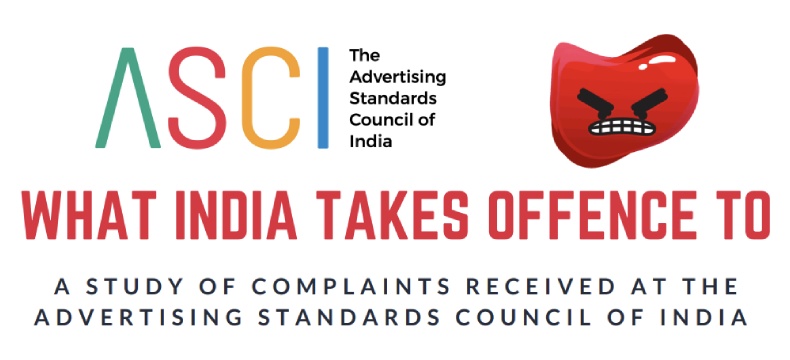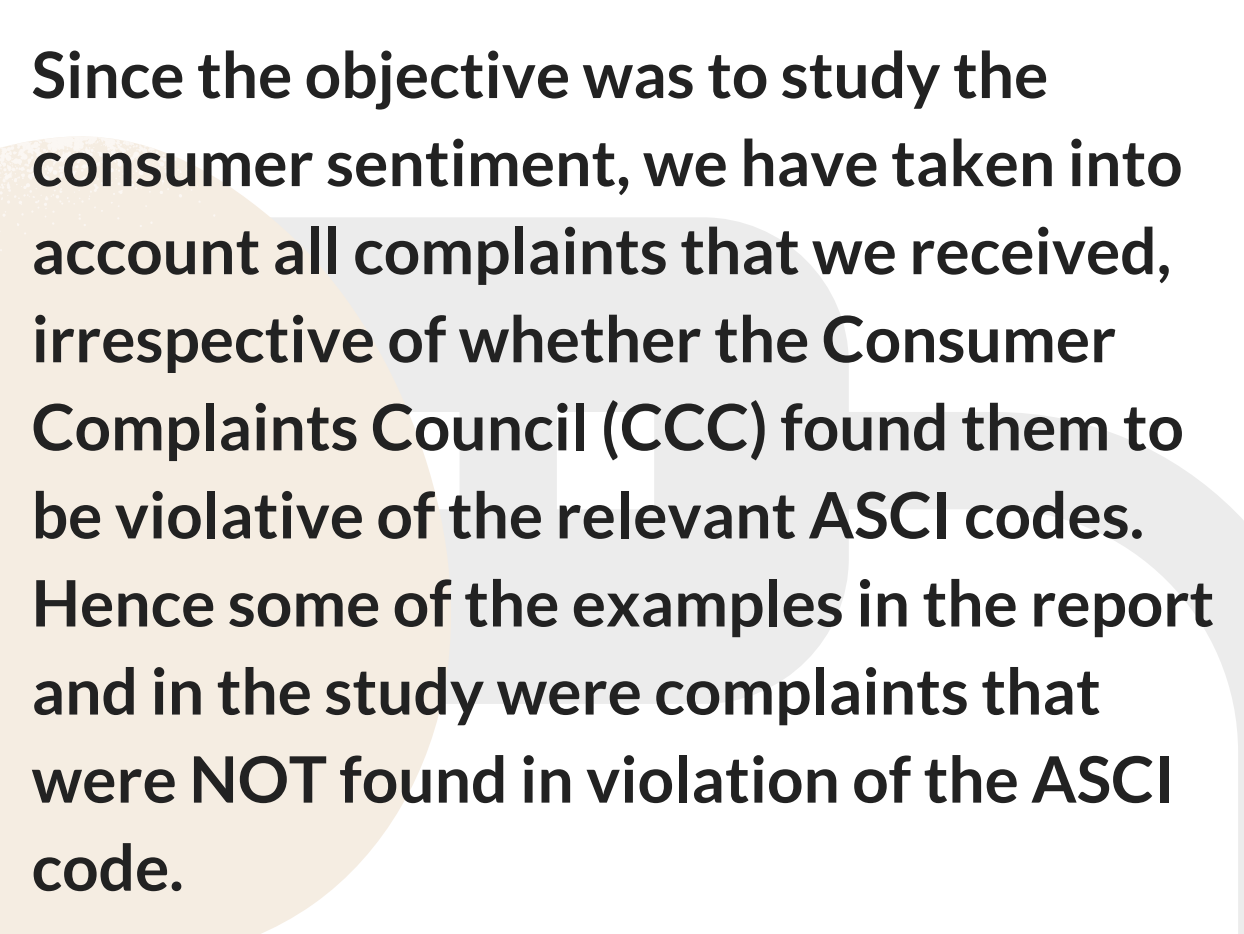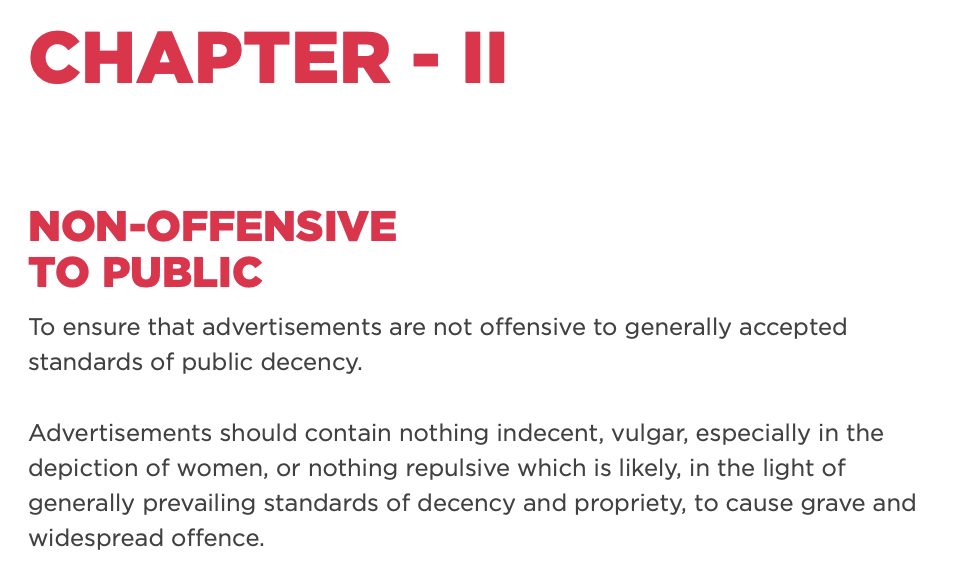
The Advertising Standards Council of India (ASCI) recently released a report titled, ” (PDF) based on 1,759 complaints received by the ASCI (against 488 ads) in the last 3 years.
ASCI had taken only those complaints that pertain to two of its four codes ():
Code 2: Non-offensive to Public
Code 3: Against Harmful Products and Situations
The other two codes are:
Code 1: Truthful & Honest Representation
Code 4: Fair in Competition
The report lists 6 major patterns in ads that people find offensive:
1. Ads that are seen to reinforce socially undesirable depictions for commercial gains
2. Ads that are seen to be inappropriate for children and are aired during prime time or family viewing time
3. Ads that portray characters that seem to either cross boundaries set by society or make fun of what the societal culture considers sacred
4. Ads that are seen to mock men
5. Ads that are seen to hurt religious sentiments
6. Ads that depict unpleasant realities
I have five specific points about this report, its purpose, and how it may/may not help.
1. About complaints NOT found in violation of ASCI’s code
Consider this complaint featured under ‘Ads that are seen to hurt religious sentiments’: “Usage of the phrase ‘upar wala’ to refer to God in ICICI business banking ad is a promotion of Islam, because there is no upar wala in sanantan dharm. God is everywhere…”
Or this complaint against a Licious ad: “The advertisement shows chicken products in a very crude and disgusting way. It seems to lure its viewers in a direct graphic manner, which is very disturbing for vegetarian families like us who have to watch these unwanted visuals on family tv channels. It is so disturbing that our children are exposed to unwarranted and non veg products on family shows”.
When you come across such ludicrous complaints (to be clear: ludicrous only to me, not to the people who wrote these to ASCI since they have as much right to hold and air these views as I have in calling them ludicrous), as an agency or a brand (the target audience for this report), you may be wondering what you are supposed to take away from these. It is then useful to read what the report says on page 3:

The report lists complaints without adding against each of those examples whether they were upheld (and the brand penalized; the ad withdrawn/edited/reshot) or not. People have been holding such opinions for a very long time. It is only in recent times, with the internet and social media, that such views were shared widely and hence propagated to a larger set of people who may or may not be thinking on these lines.
But if a complaint has not been upheld by ASCI, how useful is it to add in a report? Of course, the last page of the report explains the purpose of the report: “What this report tries to put a spotlight on, are some observations and insights that could help advertisers plan their campaigns better, or help them respond better to consumer sentiments”.
Fair enough. But such utterly random and pointless complaints are all over the internet, usually in the comments section of YouTube or on Twitter, by tons of people. Whether brands and agencies take cognizance of these or not is their choice and prerogative. Even if they do, a few random comments and sentiments do not warrant any action from the brand – only when the numbers seem adequately large should they even bother doing something about it. ASCI’s report doesn’t mention the numbers (understandably, given the universe of a mere 1,759 comments sent directly to them via email), so such anecdotal comments/sentiments are hardly useful in any meaningful sense.
2. What should be the repercussion for brands and agencies that invite such complaints?
If a complaint has been upheld, the ASCI can ask the offending ad to be withdrawn. The brand could appeal, go to court, or reshoot/edit the ad to fit the ASCI code.
But when brands and agencies get complaints or comments that disagree with something shown in the ad, and a lot of people are outraged… and yet the ASCI does not find anything offending as per its own code, what is the repercussion?
In an ideal world, the real-world repercussion for such ads is that the campaign fails its objective of selling the product or service. That is, people see the ad, get outraged about something and decide to individually not buy the product or service.
But things are not that simple. If a real estate brand has an offending ad for a property worth Rs. 4 crores (for example), the total number of people who can afford that could be far fewer than the number of people who may outrage vocally online.
On the contrary, a telecom network brand offending a lot of people through its ad may not lead to people moving away from it, given the state of our country where there are only 3 telecom networks to choose from and the price (beyond financial) of changing is high in terms of coverage, customer service, etc. Or consider a bank – if its ad offends a lot of people, depending on how intricately they use the bank’s many services, many may find it difficult to not do any business with it because of an offensive ad.
3. What is the punishment for an offending ad?
This is an extension of the previous point. ASCI’s definition of punishment could simply be about asking the brand to withdraw an ad. The real-world repercussion of an offending ad could be people not buying the product/service being sold.
But a third option has recently been made possible as we witnessed in case of the most-outraged recent ads like Tanishq, Fabindia, Ceat, among others: aggrieved individuals kick-start a campaign to,
- deliver thug-style instant justice to the so-called offending brand, like how it manifested in the Tanishq example where specific individuals who were outraged called Tanishq employees offline and threatened them because they belonged to another religion and the outragers believed that these employees were in a targeted campaign to insult Hinduism, even as the ad itself was actually talking about peaceful coexistence of religions!. The outraged group also targeted offline stores of Tanishq and gently threatened (!) them with dire consequences if the store manager did not write a note of apology and paste it on the storefront.
- get more people to pose as if they are boycotting a product or service (even if they do not, in real life) or be vocal about their outrage and anger online. This manifests in specific, quantifiable output like 1-star rating of the product’s app (for example: the Snapdeal-Aamir Khan story) or a trending hate-hashtag on Twitter (like the Titan story in Tamil Nadu)
All these are completely beyond ASCI’s purview, of course, but the report could have outlined these possibilities since they are the lived-in reality of brands and agencies in recent times, far beyond politely writing complaint emails to ASCI.
4. Code for ‘offensive’ is too broad and vague
ASCI’s 2nd code, ‘non-offensive to public’ is this:

It then gets down to the intricacies of what a complaint states specifically and how ASCI interprets it to decide whether an ad is indeed offending or not.
Consider the example of people calling out festive ads that feature women without a bindi. The outrage is usually centered around the assumption that a woman without a bindi, in a festive ad around a Hindu festival is,
- possibly a non-Hindu ad
- the brand/agency does not respect Hindi tradition enough to put a bindi on her forehead
- the brand/agency is trying to appeal to non-Hindus too by showing a woman without a bindi
- the brand/agency is pandering to deracinated, religion-agnostic people and disrespecting the devout
… and so on.
While I’m reasonably sure that ASCI would turn down such complaints about the bindi (unless there is a specific disrespectful depiction of the bindi which then deserves a serious look and action), there is no way to codify this in a useful manner for brands to do/not do. It’s completely within their right for brands to show women without a bindi and simply put it as that woman’s prerogative (which is most definitely is).
It is obviously impossible to codify the many, many, many things that may offend people, a set of examples within categories of offense would most definitely be illustrative (for instance – examples of where ASCI had upheld complaints about ads being offensive for religious reasons, offensive for vulgarity, etc.).
5. Are ads facts or fiction?
Consider this complaint from the report: “I want to raise my concerns against the advertisement of ‘Mouj’ app. In this ad, a teenager, a mouj addicted girl, is visualizing senior citizen of her family dancing in an objectionable style to awkward songs”
As usual, the complaint is the person’s prerogative, but don’t we see such scenes in movies and TV shows? Why complain only when it is featured in ads?
Is it because movies and TV shows are scripted entertainment while ads are not?
Fair enough, but consider the fact that Akshay Kumar plays a doctor in a Policybazaar ad. Akshay Kumar playing a doctor in a movie (scripted entertainment) is one thing, but him ‘playing a doctor’ in an advertisement is entirely another thing. The question again – are ads fact or fiction?
In my opinion, ads are fictional content unless otherwise stated, but they point towards factual information. That does make things more complex, I understand.
But ads are a means to something, unlike movies and TV shows where the content is the endpoint in itself. With ads, like I had written yesterday, the content is a mere vehicle towards making people perform an action. To get people to perform an action of remembering the product/service/brand in a positive manner or to buy something, advertising also uses fictional narratives using models/actors to play scripted roles (act!).
So ads are most definitely make-believe, much like movies. It’s just that the goal of advertising is different.
Consider this complaint against Pepperfry: “The Pepperfry ad shows a furious woman throwing knives at a man who is sitting and relaxing and there are several attempts made by her.”
If we are going to complain about this, then why not complain about every single movie scene where a character murders another character? After all, movies have actors playing a character, just like ads.
Do movies get a free pass just because they start with a disclaimer? Should all ads start with a disclaimer then that what is depicted is fictional? Is that not evident, understood, and implied already even without disclaimers?
Think about it.
